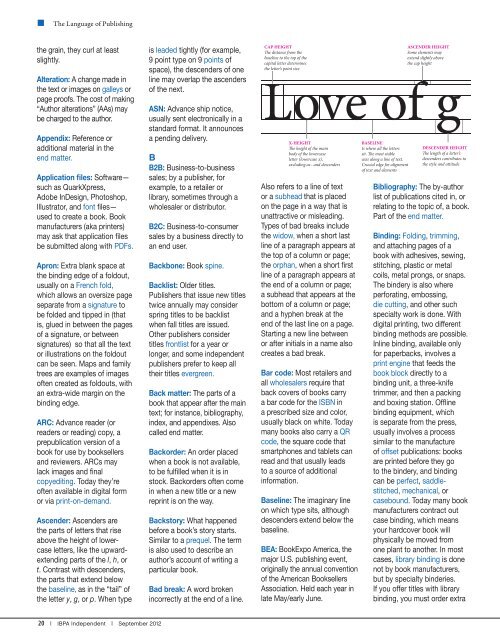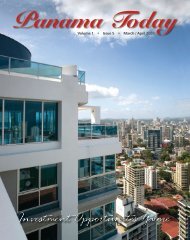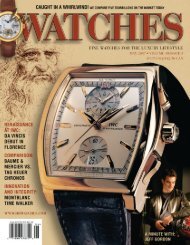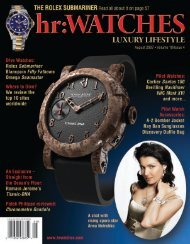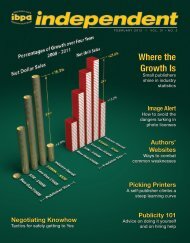■The Language of Publishingthe grain, they curl at leastslightly.Alteration: A change made inthe text or images on galleys orpage proofs. The cost of making“Author alterations” (AAs) maybe charged to the author.Appendix: Reference oradditional material in theend matter.Application files: Software—such as QuarkXpress,Adobe InDesign, Photoshop,Illustrator, and font files—used to create a book. <strong>Book</strong>manufacturers (aka printers)may ask that application filesbe submitted along with PDFs.Apron: Extra blank space atthe binding edge of a foldout,usually on a French fold,which allows an oversize pageseparate from a signature tobe folded and tipped in (thatis, glued in between the pagesof a signature, or betweensignatures) so that all the textor illustrations on the foldoutcan be seen. Maps and familytrees are examples of imagesoften created as foldouts, withan extra-wide margin on thebinding edge.ARC: Advance reader (orreaders or reading) copy, aprepublication version of abook for use by booksellersand reviewers. ARCs maylack images and finalcopyediting. Today they’reoften available in digital formor via print-on-demand.Ascender: Ascenders arethe parts of letters that riseabove the height of lowercaseletters, like the upwardextendingparts of the l, h, ort. Contrast with descenders,the parts that extend belowthe baseline, as in the “tail” ofthe letter y, g, or p. When typeis leaded tightly (for example,9 point type on 9 points ofspace), the descenders of oneline may overlap the ascendersof the next.ASN: Advance ship notice,usually sent electronically in astandard format. It announcesa pending delivery.BB2B: <strong>Business</strong>-to-businesssales; by a publisher, forexample, to a retailer orlibrary, sometimes through awholesaler or distributor.B2C: <strong>Business</strong>-to-consumersales by a business directly toan end user.Backbone: <strong>Book</strong> spine.Backlist: Older titles.Publishers that issue new titlestwice annually may considerspring titles to be backlistwhen fall titles are issued.Other publishers considertitles frontlist for a year orlonger, and some independentpublishers prefer to keep alltheir titles evergreen.Back matter: The parts of abook that appear after the maintext; for instance, bibliography,index, and appendixes. Alsocalled end matter.Backorder: An order placedwhen a book is not available,to be fulfilled when it is instock. Backorders often comein when a new title or a newreprint is on the way.Backstory: What happenedbefore a book’s story starts.Similar to a prequel. The termis also used to describe anauthor’s account of writing aparticular book.Bad break: A word brokenincorrectly at the end of a line.CAP HEIGHTThe distance from thebaseline to the top of thecapital letter determinesthe letter’s point sizeX-HEIGHTThe height of the mainbody of the lowercaseletter (lowercase x),excluding as– and descendersAlso refers to a line of textor a subhead that is placedon the page in a way that isunattractive or misleading.Types of bad breaks includethe widow, when a short lastline of a paragraph appears atthe top of a column or page;the orphan, when a short firstline of a paragraph appears atthe end of a column or page;a subhead that appears at thebottom of a column or page;and a hyphen break at theend of the last line on a page.Starting a new line betweenor after initials in a name alsocreates a bad break.Bar code: Most retailers andall wholesalers require thatback covers of books carrya bar code for the ISBN ina prescribed size and color,usually black on white. Todaymany books also carry a QRcode, the square code thatsmartphones and tablets canread and that usually leadsto a source of additionalinformation.Baseline: The imaginary lineon which type sits, althoughdescenders extend below thebaseline.BEA: <strong>Book</strong>Expo America, themajor U.S. publishing event,originally the annual conventionof the American <strong>Book</strong>sellersAssociation. Held each year inlate May/early June.BASELINEIs where all the letterssit. The most stableaxis along a line of text.Crucial edge for alignmentof text and elementsASCENDER HEIGHTSome elements mayextend slightly abovethe cap heightDESCENDER HEIGHTThe length of a letter’sdescenders contributes tothe style and attitudeBibliography: The by-authorlist of publications cited in, orrelating to the topic of, a book.Part of the end matter.Binding: Folding, trimming,and attaching pages of abook with adhesives, sewing,stitching, plastic or metalcoils, metal prongs, or snaps.The bindery is also whereperforating, embossing,die cutting, and other suchspecialty work is done. Withdigital printing, two differentbinding methods are possible.Inline binding, available onlyfor paperbacks, involves aprint engine that feeds thebook block directly to abinding unit, a three-knifetrimmer, and then a packingand boxing station. Offlinebinding equipment, whichis separate from the press,usually involves a processsimilar to the manufactureof offset publications: booksare printed before they goto the bindery, and bindingcan be perfect, saddlestitched,mechanical, orcasebound. Today many bookmanufacturers contract outcase binding, which meansyour hardcover book willphysically be moved fromone plant to another. In mostcases, library binding is donenot by book manufacturers,but by specialty binderies.If you offer titles with librarybinding, you must order extra20 | IBPA Independent | September 2012
The Language of Publishing■covers for this process. Theterm binding also means theedge of a book that is bound(binding edge).BISAC Codes: The familiarterm for the BISAC SubjectHeadings used to categorizebooks according to theirsubjects and to standardizethe electronic transfer ofsubject information betweenpublishers and booksellers.The complete BISAC SubjectHeadings list is free for bookby-booklookup at bisg.org.Blad: <strong>Book</strong> layout and design.A printed sample used bysales reps to sell a title inadvance of publication. Itoften features sections fromthe finished book, includingcover artwork, page layouts,and images. Most commonlyused today for children’spicture books.ensure the margin is completelycovered with ink. Bleeds acrossgutters (i.e., between the twopages of a spread) are notavailable with digital printing.Because paper is wasted withbleeds, printers charge morefor jobs with them. The termalso describes ink that hasspread into parts of the pagewhere it should not.Bleedthrough: When one sideof a sheet is heavily inked, thepaper may absorb so muchink that the type or imagescan be seen on the reverseside. More common with thinpaper, bleedthrough should becorrected at the press check.Blind embossing: A printingtechnique in which a bas-reliefdesign is created without foilor ink.Blind folio: A page numberthat is assigned to a page(such as the title page andother front matter pages) butnot printed on it.Board book: Made withsturdy, cardboard-type pagesand covers. Usually for youngchildren, and limited in numberof pages.Boldface: Thicker, visuallyheavier or darker type. Indesktop publishing programssuch as InDesign, the strokemenu can be used to furtherincrease the thickness of type.<strong>Book</strong> block: The pagesof a book after they havebeen printed and folded andgathered but before the coveris attached. With sheet-feddigital presses, the book blockis a stack of single pages. Withoffset presses, either sheet-fedor web, the block is a stack ofpartial or full signatures.<strong>Book</strong> designer: A graphicdesigner with specializedexperience in book designand an understanding of bookmanufacturing.<strong>Book</strong> doctor: A consultantwho edits a manuscript interms of basic structure andcontent. A book doctor maybe hired by an author toget a manuscript ready forsubmission to a publisher,or by a publisher with amanuscript that needssignificant work.<strong>Book</strong> packager: Traditionallyan individual or company thatassembled the components ofa book (including text, images,design, and possibly relatedmaterials, such as implementsor materials used in theprojects described in the book)and marketed the package toa publisher. Today often usedto refer to businesses thatassemble the componentsof a book (possibly on aDESIGNtoCOVER.comPUBLICATION DESIGNBleed: An image or text thatextends (“bleeds”) over oneor more edges of a page.Publishers asking printers forquotes on a book with coveror text bleeds must specifyhow many bleeds it will have;for example, “cover bleedsone side” or “cover bleedsfour sides.” A full-bleed imageextends (that is, bleeds) overall the edges so there is nounprinted gutter or margin.Most printers require thatartwork extend at least aneighth of an inch (a quarterinch for digital printed or webpress jobs) past the trim line toBlock style: When all lines ofa piece of text, including thefirst, are set flush left.Blueline or Blues: The finalone-color print-on-paper copyof a book or other publicationbefore it goes to the press, andthe last chance to fix anythingthat needs fixing. Printerssometimes charge extra for ablueline, which is made fromfilm and light-sensitive paper.Any changes made at theblueline stage are expensive.Also called a silverprint,brownline, or Van Dyke. Withdigital reproduction, there is nofilm; instead, you can checkthe laser print.Blurb: An endorsement, oftenby someone well known, usedin the front matter, the cover,and promotional material.Good page design should enhancethe written word not dominate it.We strive to deliver creative yetfunctional books. Attention to detailhelps us produce high quality designsthat meet your high standards andcomplement your content.Contact us today for help withyour next publishing project!mkharvey@designtocover.com 607.748.07281010101010100001010101111100010101010101011010101010100001110000111100011 1010101010100001010101111100010101010101011010101010100001010100001010101111100010101010101011010101010100001110000111100011 101010101010000101010111110001010101010101101010101010000111000001010101111100010101010101011010101010100001110000111100011 101010101010000101010111110001010101010101101010101010000111000011110001111100010101010101011010101010100001110000111100011 1010101010100001010101111100010101010101011010101010100001110000111100011 010101010101011010101010100001110000111100011 1010101010100001010101111100010101010101011010101010100001110000111100011 1010101010110101011010101010100001110000111100011 1010101010100001010101111100010101010101011010101010100001110000111100011 1010101010100001011010101010100001110000111100011 1010101010100001010101111100010101010101011010101010100001110000111100011 101010101010000101010111010100001110000111100011 1010101010100001010101111100010101010101011010101010100001110000111100011 10101010101000010101011111000101110000111100011 1010101010100001010101111100010101010101011010101010100001110000111100011 101010101010000101010111110001010101010111100011 1010101010100001010101111100010101010101011010101010100001110000111100011 1010101010100001010101111100010101010101011011 1010101010100001010101111100010101010101011010101010100001110000111100011 101010101010000101010111110001010101010101101010101011010100001010101111100010101010101011010101010100001110000111100011 101010101010000101010111110001010101010101101010101010000111001010101111100010101010101011010101010100001110000111100011 10101010101000010101011111000101010101010110101010101000011100001111111100010101010101011010101010100001110000111100011 1010101010100001010101111100010101010101011010101010100001110000111100011 1010101010101011010101010100001110000111100011 1010101010100001010101111100010101010101011010101010100001110000111100011 101010100101011010101010100001110000111100011 1010101010100001010101111100010101010101011010101010100001110000111100011 10101010101000010101010100001110000111100011 1010101010100001010101111100010101010101011010101010100001110000111100011 10101010101000010101011010101111100010101010101011010101010100001110000111100011 10101010101000010101011111000101010101010110101010101000011100001111110000111100011 101010101010000101010111110001010101010101101010101010000111000011110001110101000010101011111000101010101010111 1010101010100001010101111100010101010101011010101010100001110000111100011 1010100001010101111100010101010101011010101010100001110000111100011 01010101111100010101010101011010101010100001110000111100011 10101010101000010101011111000101010101010110101010101000011100001111100010101010101011010101010100001110000111100011 10101010101000010101011111000101010 00011 1010101010100001010101111100010101010101011010101010100001110000111100011 10101011010101010100001110000111100011 101011010101010100001110000111100011 1010101010100001010101111100010101010101011010101010100001110000111100011 10101010101000101010100001110000111100011 1010101010100001010101111100010101010101011010101010100001110000111100011 101010101010000101010100001110000111100011 1010101010100001010101111100010101010101011010101010100001110000111100011 101010101010000101010111110010000111100011 1010101010100001010101111100010101010101011010101010100001110000111100011 10101010101000010101011111000101011100011 101010101010000101010111110 1010101010100001010101111100010101010101011010101010100001110000111100011 101010100001110000111100011 1010101010100001010101111100010101010101011010101010100001110000111100011 10101010101000010101000001110000111100011 1010101010100001010101111100010101010101011010101010100001110000111100011 1010101010100001010101111100000111100011 1010101010100001010101111100010101010101011010101010100001110000111100011 1010101010100001010101111100010101100011 1010101010100001010101111100010101010101011010101010100001110000111100011 10101011010101010100001110000111100011 0101011010101010100001110000111100011 1010101010100001010101111100010101010101011010101010100001110000111100011 101010101010101010100001110000111100011 1010101010100001010101111100010101010101011010101010100001110000111100011 101010101010000110100001110000111100011 1010101010100001010101111100010101010101011010101010100001110000111100011 10101010101000010101011PRINT YOUR TITLESWITH US AND $AVE!Covering your printing needs on both ends of thespectrum: Large volume by overseas printing,short-run with digital on-demand printing.CALL USFOR FREEQUOTES!SUMMER SPECIAL!New customersreceivesOFF* Offer good for new customer and digital printing only. Cannotbe combined with any other offer.14730 Central Ave., Chino, CA 91710sales@crossblue.com • www.crossblue.comVisit the IBPA website at www.ibpa-online.org | 210000111100011 1010101010100001010101111100010101010101011010101010100001110000111100011 1010101010100001010*


